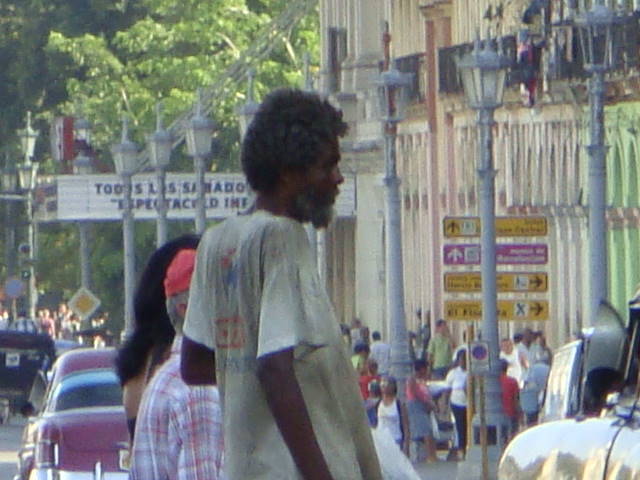In the city of Havana, the number of mentally ill street people in their filthy and ragged clothing increases on a daily basis. The number of beggars is also going up — you can find them in just about any doorway lying on cardboard asking for change with their lost looks. And on any corner there are street vendors selling peanuts, cheap things, loose cigarettes and second-hand items.
It is almost a legion. Walk around the old Capitol Building and Central Park and you will see more than a few senior citizens, dressed in worn-out but clean clothing, all asking for money from the pale European tourists, who, fascinated by all of this, shoot photographs in bursts with their digital cameras. You’ll also see 11- or 12-year old children begging for money from the foreigners.
Not far away, a robust black man announces that he has souvenir pictures for the photo albums of the travelers. He takes their photographs in black and white using a box camera from the beginning of the 20th century. Close by, a group of beggars takes turns holding out their hands without thinking twice about badgering the foreigners.
The troupe of beggars doesn’t just swarm around the areas where distracted tourists tend to wander. No. The scene is a frequent one on any central street in Havana. Or in cafés or stores that only deal in foreign currency.
When the brutal cold wave passed over Cuba during the first fortnight of January — 26 patients admitted into the psychiatric hospital in the capital died due to hypothermia and lack of food — when this happened, the mentally ill street people and vendors magically disappeared.
They were sent to decrepit shelters and guaranteed two frugal meals a day. But the sun warmed things back up again and they returned to their everyday affairs of trying to win some small change or sell cigarettes and cheap items of limited utility.
If there is anything that fills the revolution of Fidel Castro with pride, it is that at the beginning of 1959, when the lawyer from Birán took the reins of power, you hardly saw any beggars who were out of their minds and demanding.
Back then, there were lunatics who were brilliant and agreeable, like the famous Gentleman from Paris, who was born in Galicia. He was a crazy, extravagant person who composed poems, and who on avenues and corners in the center of Havana, gave passionate dissertations in the style of an 18th century Spaniard.
Later, when the Berlin Wall fell and the USSR closed the spigot of oil and rubles to Castro, there was a resurgence of a range of flabbergasted scruffy vagabonds who rummaged around in garbage cans looking for left-over food or an old piece of clothing or something to sell.
It is a habitual sight to see extensive legions of poverty-stricken people who have nothing in any Latin-American city you might name. Those images which used to be unpublished in Cuba, now form part of our urban landscape. As a result of the 26 deaths in the psychiatric hospital, known as Mazorra, and the hair-raising earthquake in Haiti that snuffed out the lives of almost 100,000 people, those of us here on the ground on the island have been left in shock.
Caridad Ruiz, who is 73 years old and an indigent without a roof who sleeps on newspapers on the pavement of the 10th of October Street, says that on those icy days her beggar’s cup with the faded image of Saint Lazarus filled with coins. “People were more sensitive, I could eat hot food and have some rum to warm my stomach.” That’s what the old lady says as she continues to beg for money from anyone who walks through the doorways of the popular avenue.
It could be that in Havana the crowd of beggars, the alienated and the vendors of peanuts, cigarettes and newspapers are not so numerous as in Lima, Río de Janeiro or La Paz. But we are getting there.
Iván García

